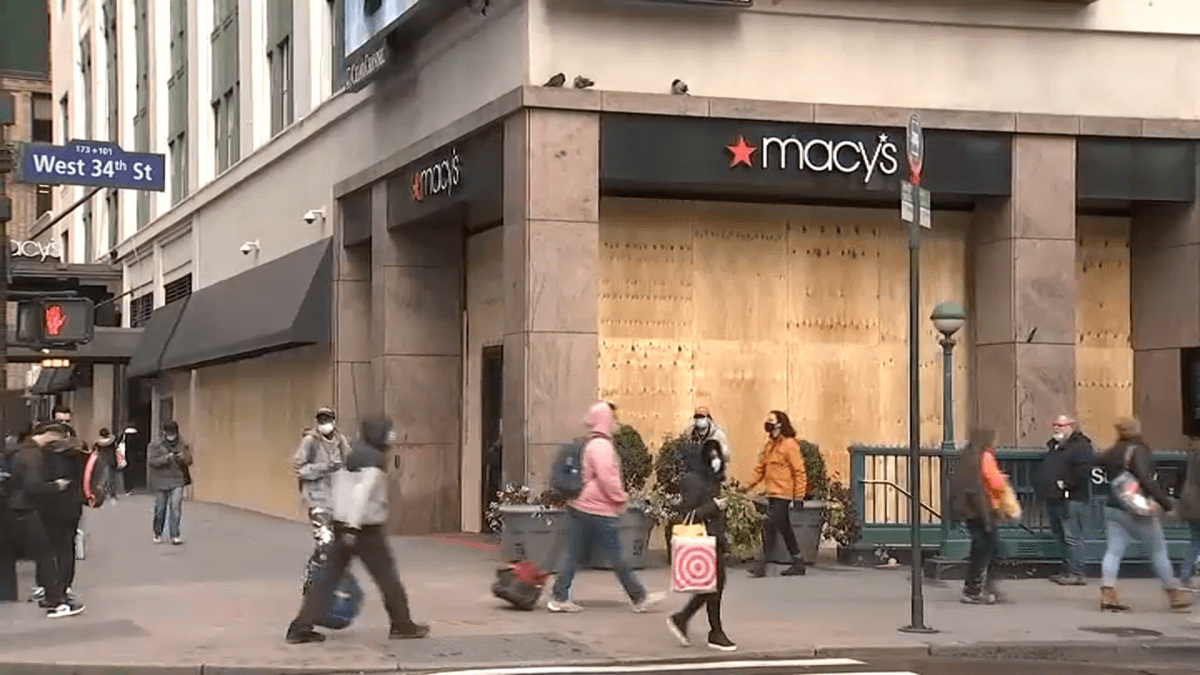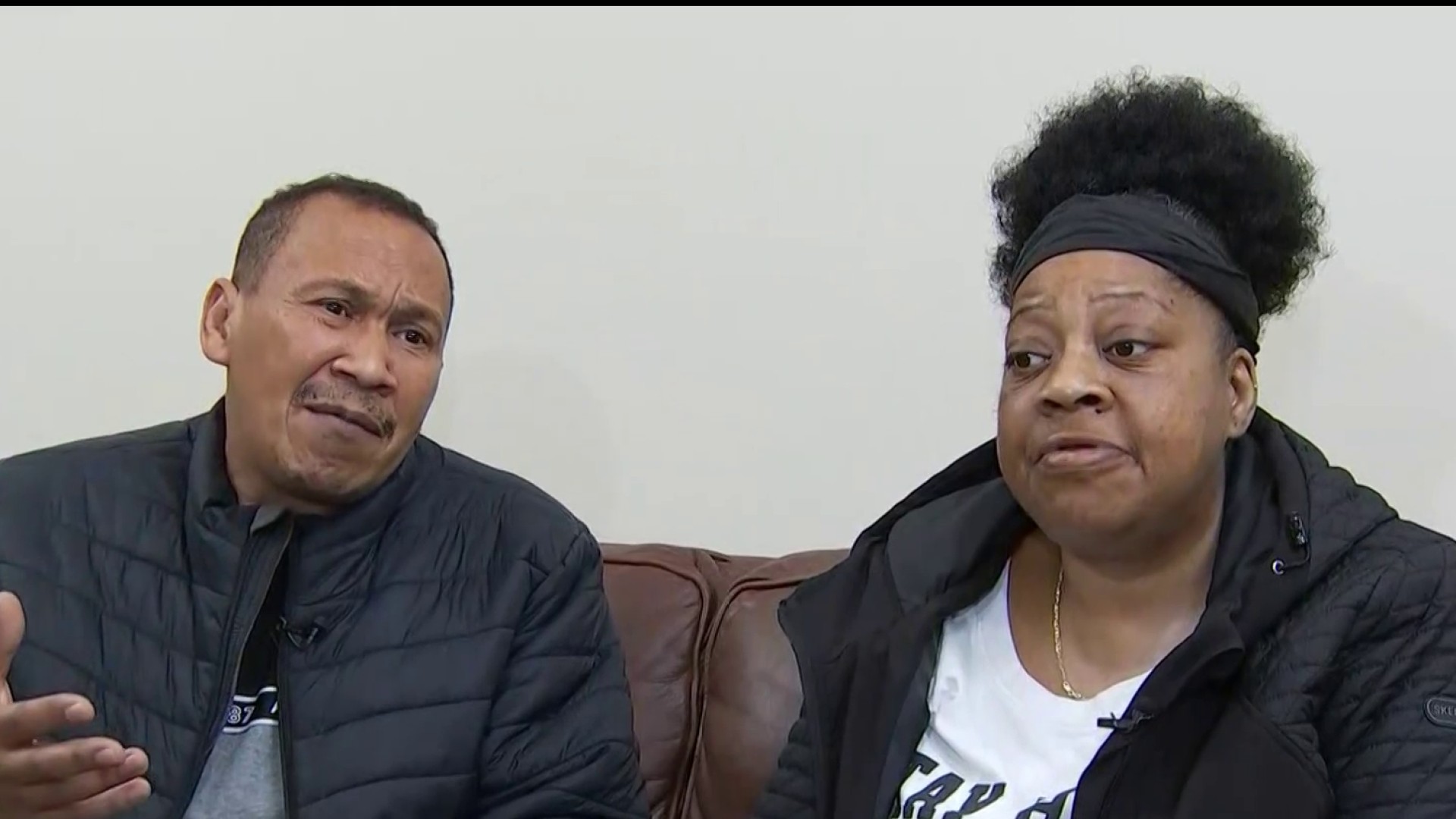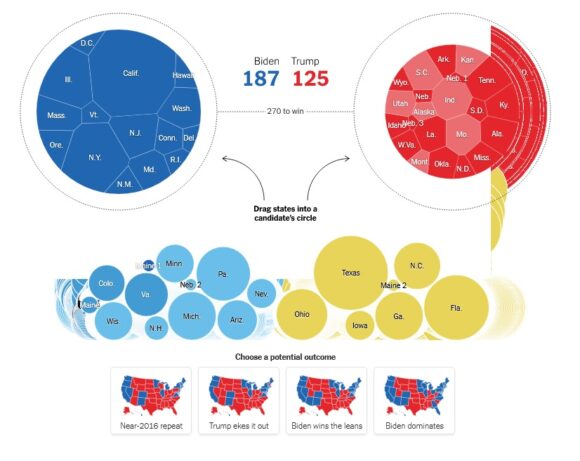Although many winners may quickly be evident on election night, the increase in mail voting because of the pandemic is expected to push back the release of full results in many key states.
The New York Times asked officials in every state and the District of Columbia about their reporting processes and what share of votes they expect to be counted by noon on Wednesday, Nov. 4. There is a fair amount of uncertainty surrounding results in any election, but below is what they said to expect.
Tony
————————————-
|
State |
Timing of results |
When last polls close (Eastern time) |
Type of ballots reported first |
Can postmarked ballots arrive later? |
Do those who request a mail ballot but vote in person instead cast a provisional ballot? |
|---|---|---|---|---|---|
|
Alabama
Solid R
|
The secretary of state has said to expect all unofficial results on election night. |
8 p.m. |
No order |
No |
Yes, reviewed later |
|
Alaska
Likely R
|
The only results reported on election night will be from in-person early voting through Oct. 29 and from the precincts on Election Day. No mail or other absentee ballots will be counted until about a week later. |
1 a.m. (most at midnight) |
Early in-person and Election Day ballots |
Yes, by Nov. 13. No mail ballots counted until around Nov. 10. |
No |
|
Arizona
Lean D
|
Officials are not predicting the share of ballots that will be reported by Wednesday. A new law allows officials to count mail votes starting two weeks before the election, so the first votes, typically reported at 10 p.m. Eastern, are likely to be relatively stronger for Mr. Biden. |
9 p.m. |
Early votes (in-person and mail ballots arriving before Election Day) |
No |
Yes, reviewed later |
|
Arkansas
Solid R
|
Officials estimate that nearly all votes will be reported by noon on Wednesday. |
8:30 p.m. |
Varies by county, but early in-person votes often first |
No |
Yes, reviewed on election night |
|
California
Solid D
|
Officials did not make a timing estimate but noted that all active registered voters were sent mail ballots, and that late-arriving mail ballots and provisional ballots would be counted over the following days and weeks. |
11 p.m. |
Mail ballots arriving before Election Day |
Yes, as late as Nov. 20 |
Yes, in some counties, if voter does not surrender mail ballot. Reviewed later. |
|
Colorado
Likely D
|
Officals estimate that 75 percent to 80 percent of votes will be reported by midday Wednesday, depending on how many voters wait to return their ballot or decide to vote in person on Election Day. |
9 p.m. |
No order, most vote by mail |
No |
No |
|
Connecticut
Solid D
|
Officials said it is impossible to predict when all votes will be reported, but for most towns, it will probably be earlier than the statutory deadline of 96 hours (Saturday). |
8 p.m. |
No order |
No |
No |
|
Delaware
Solid D
|
Officials estimate that more than 99 percent of votes will be reported by noon on Wednesday. |
8 p.m. |
No order |
No |
No |
|
District of Columbia
Solid D
|
Officials did not have an estimate for the timing of results. |
8 p.m. |
Early in-person and processed mail ballots |
Yes, by Nov. 13. Reported on a rolling basis. |
No, as long as the voter has not already mailed in a ballot. |
|
Florida
Tossup
|
All early voting and previously tabulated mail ballots, which are likely to be relatively stronger for Mr. Biden, should be reported by 8:30 p.m. Eastern. Officials did not make a projection for the timing of full unofficial results, but they were allowed to process early-arriving mail ballots starting weeks before the election. |
8 p.m. (most at 7 p.m.) |
Early in-person and counted mail ballots |
No |
Yes, if voter does not surrender mail ballot. Reviewed later. |
|
Georgia
Tossup
|
Officials did not provide an estimate but said that because of the large volume of mail ballots expected, it could take a couple of days for all of them to be scanned and counted. The secretary of state has said he expects the winners of most races to be announced by Nov. 4. |
7 p.m. |
No order |
No |
No. If a voter does not surrender a mail ballot, the voter can sign an affidavit and cast a regular ballot. |
|
Hawaii
Solid D
|
Votes are released in three stages, with early mail ballots at midnight Eastern, in-person votes at 3 a.m. Eastern and a final report later. Officials estimate that 95 percent to 99 percent of votes will be reported as of Wednesday. |
Midnight |
Mail ballots processed up to Election Day |
No |
No |
|
Idaho
Solid R
|
Officials estimate that nearly all votes will be reported by noon on Wednesday. |
11 p.m. (some at 10 p.m.) |
No order |
No |
No |
|
Illinois
Solid D
|
Officials did not have an estimate, saying that timing will depend on when voters return their ballots. The number of mail ballots that have not yet been returned will be reported here. |
8 p.m. |
Early in-person and processed mail ballots |
Yes, by Nov. 17 |
Yes, if voter does not surrender mail ballot. Counted within two weeks. |
|
Indiana
Likely R
|
Officials say the speed of counting will depend on the volume of absentee ballots, and that a more complete picture of results may not be available for several days after the election. |
7 p.m. (most at 6 p.m.) |
No order |
No |
In some situations |
|
Iowa
Tossup
|
Officials said they are confident they will have unofficial results “in a timely fashion like we do for every election.” |
10 p.m. |
Absentee ballots likely first |
Yes, by Nov. 9 |
Yes, if voter does not surrender mail ballot |
|
Kansas
Likely R
|
Officials said they could not speculate on the timing of results but noted that the state did not experience systematic delays in its Aug. 4 primary. |
9 p.m. (most at 8 p.m.) |
Typically early in-person and some mail votes |
Yes, by Nov. 6. Results reported daily. |
Yes, reviewed between Nov. 9 and Nov. 17 |
|
Kentucky
Solid R
|
Officials said they could not speculate on the timing of complete results. Counties have been instructed to report all in-person votes and mail ballots arriving by 6 p.m. by midnight on election night. |
7 p.m. (6 p.m. in some counties) |
No order |
Yes, by Nov. 6. Results reported on Nov. 6 and 10. |
No |
|
Louisiana
Solid R
|
No timing estimates provided. |
9 p.m. |
No order |
No |
No |
|
Maine
Likely D*
Solid D (1st Dist.), Tossup (2nd Dist.)
|
Officials are not expecting delays processing mail ballots unless most absentee voters wait until Election Day to return them. |
8 p.m. |
No order |
No |
No |
|
Maryland
Solid D
|
Officials said they could not estimate how many votes would be reported by noon on Wednesday. |
8 p.m. |
Early in-person and counted mail ballots |
Yes, by Nov. 13. Results reported each day those ballots are counted. |
Yes, reviewed beginning Nov. 12 |
|
Massachusetts
Solid D
|
In recent elections, 97 percent of votes were reported by noon on Wednesday. Officials say they do not expect any changes to the number of precincts reporting this year but noted that ballots arriving on Election Day and after will be counted on or after Nov. 6. |
8 p.m. |
No order |
Yes, by Nov. 6. Officials will start counting ballots arriving after 5 p.m. on Nov. 3 on Nov. 6. |
No |
|
Michigan
Lean D
|
Officials have said that full unofficial results could take until Nov. 6. Processing of ballots does not begin until Election Day, or the day before the election in some jurisdictions. If there are a significant number of mail ballots outstanding at the end of election night, the reported totals could be relatively stronger for Mr. Trump. |
9 p.m. (most at 8 p.m.) |
No order |
No |
No. If a voter does not surrender a mail ballot, the voter can sign an affidavit to cancel it and cast a ballot that will be tabulated that day. |
|
Minnesota
Lean D
|
Officials expect to count and report close to 100 percent of votes cast on or before Election Day by noon Wednesday. Outstanding mail ballots will be reported on the secretary of state’s website. |
9 p.m. |
No order |
Yes, by Nov. 10. Results reported daily. |
No |
|
Mississippi
Solid R
|
Officials estimate that 90 percent to 95 percent of votes will be reported by noon on Wednesday. |
8 p.m. |
No order |
Yes, by Nov. 10. No reporting schedule for results. |
Yes, reviewed during 10 days following election |
|
Missouri
Likely R
|
Officials estimate that more than 99 percent of votes will be reported by noon on Wednesday. |
8 p.m. |
No order |
No |
No |
|
Montana
Likely R
|
Officials said they expect timely results from the counties. Most voters were sent mail ballots. |
10 p.m. |
Typically mail and other absentee ballots start to be reported first. |
No |
No |
|
Nebraska
Solid R*
Lean D (2nd Dist.)
|
No details provided. |
9 p.m. |
|
No |
Yes, if the voter did not return the ballot or lost it. Reviewed within 10 days. |
|
Nevada
Lean D
|
Officials said they did not know what share of votes would be reported by noon Wednesday. Ballots were mailed to all active registered voters. |
10 p.m. |
No order |
Yes, by Nov. 10. Results reported daily. |
No, as long as the voter has not already mailed in a ballot. |
|
New Hampshire
Lean D
|
No details provided. |
8 p.m. (most at 7 p.m.) |
|
No |
No |
|
New Jersey
Solid D
|
Officials said they did not have a prediction for when a complete count would be available. Mail ballots were sent to all active, registered voters. It took weeks to finish counting ballots during the state’s July primary. |
8 p.m. |
No order |
Yes, by Nov. 10. Reporting varies by county. |
Yes, counted beginning Nov. 10 |
|
New Mexico
Solid D
|
Officials did not provide an estimate but said that they expected that the majority, if not all, of the winners in the state would be evident by midday Wednesday. |
9 p.m. |
Early in-person and processed mail ballots |
No |
No. Voter can sign an affadavit to cancel mail ballot and cast a regular ballot in person. |
|
New York
Solid D
|
Only unofficial results from in-person early and Election Day voting will be released on election night. Absentee ballots will be reported in the following days, depending on the county. It took weeks to finish counting ballots during the state’s June primary. |
9 p.m. |
In-person early and Election Day ballots |
Yes, by Nov. 10. Results reporting varies by county. |
No. If a voter casts an in-person ballot, the absentee ballot is set aside and not counted. |
|
North Carolina
Tossup
|
Early votes and processed mail ballots, which are likely to be relatively stronger for Mr. Biden, will be reported around 7:30 p.m. Election day results, which are likely to be relatively stronger for Mr. Trump, will be reported between 8:30 p.m. and 1 a.m. Officials estimate that upward of 98 percent of ballots cast will be reported on election night. |
7:30 p.m. |
Early in-person and processed mail ballots |
Yes, by Nov. 12 |
No |
|
North Dakota
Solid R
|
Officials expect all ballots cast before and on Election Day to be reported by noon on Wednesday. The timing of complete unofficial results will depend on how many postmarked ballots arrive after Election Day. |
9 p.m. |
No order |
Yes, by Nov. 9. All ballots arriving after Election Day reported on Nov. 9. |
No |
|
Ohio
Tossup
|
Ballots cast before Election Day will be reported by 8 p.m., and they are likely to be relatively stronger for Mr. Biden. They will be followed by those cast in-person or arriving on Election Day. After election night, no more results will be released until final certification, which must be completed by Nov. 28. No predictions were provided for the share of results reported by Wednesday. |
7:30 p.m. |
Absentee ballots cast in-person or by mail before Election Day |
Yes, by Nov. 13. All ballots arriving after Election Day reported by Nov. 28. |
Yes, only for those voting on Election Day. Reported by Nov. 28. |
|
Oklahoma
Solid R
|
Officials said that they do not have an estimate for when full unofficial results will be available, but that typically all counties finish reporting results on election night. |
8 p.m. |
Typically, early in-person results |
No |
No |
|
Oregon
Solid D
|
Officials do not have an estimate for when full unofficial results will be available. In the past two general elections, about 10 percent of votes remained outstanding by noon on Wednesday. |
11 p.m. (some 10 p.m.) |
No order, vote entirely by mail |
No |
No |
|
Pennsylvania
Lean D
|
Secretary of the Commonwealth Kathy Boockvar has said that she expects “the overwhelming majority” of votes will be counted by Friday, Nov. 6. Officials cannot begin to process mail ballots until Election Day, and if there are a significant number of mail ballots outstanding at the end of the night, the reported totals could be relatively stronger for Mr. Trump. |
8 p.m. |
Officials did not specify, but Ms. Boockvar has said that in order to prevent large swings in results, she is asking counties to report mail votes routinely instead of all at once. |
Yes, by Nov. 6. Reporting will vary by county. |
Yes, if voter does not surrender mail ballot. Reviewed within seven days. |
|
Rhode Island
Solid D
|
The state had initially planned not to report any mail votes on election night, but its elections board voted Monday to release a first count at 11 p.m. A second count will be released the next day; a third will be released when all mail votes have been counted; and a fourth, final release (to resolve any ballots with outstanding issues) will occur the week after the election. |
8 p.m. |
In-person votes |
No |
Yes, reviewed within two days. |
|
South Carolina
Likely R
|
Officials say that their goal is to release 100 percent of results on election night, but that the number of mail ballots could push processing into Wednesday in some counties. |
7 p.m. |
Varies by county |
No |
Yes, if voters say they never received ballot. Reviewed on Nov. 6. |
|
South Dakota
Solid R
|
No statewide estimates on timing provided, but officials in Minnehaha County, which includes Sioux Falls, said they planned to finish counting ballots late on Nov. 4. |
9 p.m. (most at 8 p.m.) |
Varies by county |
No |
No |
|
Tennessee
Solid R
|
Officials say they cannot predict but hope that more than 99 percent of votes will be reported by noon on Wednesday. |
8 p.m. |
No order |
No |
Yes. Most will be reviewed and counted within four business days of the election, if the voter’s mail ballot has not been received. |
|
Texas
Tossup
|
No estimate was provided for the share that will be reported by Wednesday. Because an excuse is required to vote by mail in Texas, officials do not think that processing those votes will result in delays, though increased turnout could. |
9 p.m. (most at 8 p.m.) |
Depends on the county. |
Yes, by Nov. 4. Reporting varies by county. |
Yes, if voter does not surrender mail ballot. |
|
Utah
Likely R
|
Officials did not have an estimate for when full unofficial results will be available. In the past two general elections, about 30 percent of votes remained outstanding by noon on Wednesday. |
10 p.m. |
No order, most vote by mail. |
Yes, by Nov. 10 to Nov. 17, depending on the county. Reported daily. |
Yes, if voter does not surrender mail ballot. Reviewed by Nov. 17. |
|
Vermont
Solid D
|
Officials estimate that unofficial results will be available for most or all precincts by midnight. |
7 p.m. |
No order |
No |
No |
|
Virginia
Likely D
|
Election Day in-person votes, which are likely to be relatively stronger for Mr. Trump, are likely to be reported first in most counties. After an 11 p.m. deadline, counties must report all early in-person ballots and mail ballots processed up to that point. Officials did not estimate what share would be reported by Wednesday. |
7 p.m. |
In most counties, in-person Election Day votes |
Yes, by noon on Nov. 6. Mail ballots processed after election night will be reported on Friday, Nov. 6. |
Yes, if voter does not surrender mail ballot |
|
Washington
Solid D
|
Officials estimate that less than 50 percent of votes will be reported on election night. |
11 p.m. |
No order, most vote by mail |
Yes, by Nov. 23. |
No |
|
West Virginia
Solid R
|
Officials did not provide an estimate, saying the timing would depend on how many people request absentee ballots and return them before Election Day. |
7:30 p.m. |
No order |
Yes, by Nov. 9. Those arriving after Election Day reported Nov. 9. |
Yes, if voter does not surrender mail ballot. Reviewed beginning Nov. 9. |
|
Wisconsin
Lean D
|
Gov. Tony Evers has said he expects to know the results on election night, or by the day after at the latest. The elections director in Milwaukee County, which officials say has the potential to be the latest to report, said that results could take until between 3 a.m. and 6 a.m. Wednesday. |
9 p.m. |
No order in most places, but in-person votes could come first in 39 municipalities that count absentee ballots separately (including Milwaukee). |
No |
No |
|
Wyoming
Solid R
|
Officials have said they expect more than 99 percent of votes to be reported by noon on Wednesday. |
9 p.m. |
No order |
No |
Yes, reviewed on election night. |











